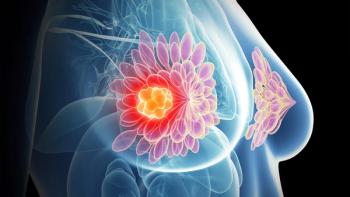
PALB2, BRCA2 Gene Mutations Confer Similar Breast Cancer Risk
Women harboring a loss-of-function mutation in the PALB2 gene demonstrated an increased risk of developing breast cancer that was similar to the predisposition seen with mutations in the infamous BRCA gene, according to a study published in The New England Journal of Medicine (NEJM).
Marc Tischkowitz, MD, PhD
Women harboring a loss-of-function mutation in the PALB2 gene demonstrated an increased risk of developing breast cancer that was similar to the predisposition seen with mutations in the infamous BRCA gene, according to a study published in The New England Journal of Medicine (NEJM).
The estimated cumulative risk of breast cancer for female PALB2 mutation carriers was 14% by age 50 and 35% by 70, representing a significant increase over the general population. The relative risk associated with PALB2 mutations was 8 to 9 in individuals below age 40, 6 to 8 for those between 40 and 60, and approximately 5 for those 60 and older. In general, the risk of developing breast cancer by age 70 for women with a mutation in BRCA1 or BRCA2 is approximately 60% and 45%, according to the National Cancer Institute.
"Since the BRCA1 and BRCA2 mutations were discovered in the mid-90s, no other genes of similar importance have been found. PALB2 is a potential candidate to be BRCA3," lead study author Marc Tischkowitz, MD, PhD, a researcher in the department of medical genetics at the University of Cambridge, said in a statement. “Now that we have identified this gene, we are in a position to provide genetic counseling and advice. If a woman is found to carry this mutation, we would recommend additional surveillance, such as MRI breast screening.”
The PALB2 gene codes the PALB2 protein that interacts with BRCA2 allowing it to connect with BRCA1, forming the BRCA complex. Monoallelic PALB2 gene mutations disrupt DNA repair pathways, by inhibiting the homologous recombination process. Past studies have linked PALB2 mutations with a higher risk of developing breast and pancreatic cancer; however, the exact risk had not been quantified prior to this study.
In the analysis, 154 families with a least one member who had breast cancer and a germline PALB2 mutation were analyzed. These families included 311 women (229 with breast cancer) and 51 men (7 with breast cancer) with PALB2 mutations. Altogether, 48 different loss-of-function mutations were detected in the PALB2 gene, which is located on chromosome 16p12.2 and contains 13 exons.
The level of risk varied based on family history for female PALB2 mutation carriers. For women with a mother who developed breast cancer at 35 or younger, the risk at age 50 was 23% and was 52% at 70. The highest risk was seen in women with both a mother and sister diagnosed with breast cancer by age 50. For these patients, the risk of developing breast cancer was 27% and 58% at age 50 and 70, respectively. For those without a family history of breast cancer, the estimated risk of developing breast cancer at age 50 was 14% and reached 35% by age 70.
Traditionally, BRCA1/2 mutations have also been connected with an increased risk of ovarian cancer. At age 70, the risk for BRCA1 mutation carriers is 39% and 11-17% with BRCA2. In the NEJM study, the risk of developing ovarian cancer was increased by a factor of 2.31 in the PALB2 carriers (95% CI, 0.77-6.97; P = .18). However, this finding was not deemed statistically significant. The authors noted that a larger study will be needed to determine whether PALB2 mutations increases a women's risk of developing ovarian cancer.
"On the basis of our estimates, the breast cancer risk for a PALB2 mutation carrier, even in the absence of a family history of breast cancer, would be classified as high according to various guidelines," the authors of the study wrote. "This level of risk may justify adding PALB2 to genetic testing for BRCA1 and BRCA2."
Based on these promising results and those demonstrated in previous trials, a number of studies are exploring PALB2 in patients with cancer. One study is looking at the incidence of BRCA1/2, PALB2, and PTEN mutations in patients with triple-negative breast cancer. Additionally, a phase II study is exploring treatment with gemcitabine and cisplatin with or without the PARP inhibitor veliparib in patients with pancreas adenocarcinoma harboring a BRCA or PALB2 mutation.
"Loss of heterozygosity at the PALB2 locus is likely to result in increased sensitivity to cell death with PARP inhibition, given that synthetic lethality is seen with other proteins that are involved in homologous recombination," Michele K. Evans, MD, and Dan L. Longo, MD, wrote in an editorial published along with the research article in NEJM.
Newsletter
Knowledge is power. Don’t miss the most recent breakthroughs in cancer care.
















































































